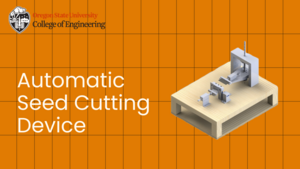
College of Engineering Unit:
Since 1909 the Oregon State University Seed Laboratory has performed research and testing on many different types of seeds. Today the Seed Lab processes thousands of samples every year from local, national, and international sources. One of the most common kinds of testing they perform is seed viability. This test takes a seed sample and determines what percentage of a given crop is likely to germinate when planted. This allows growers to anticipate yields and adjust for seed fertility, something essential to Oregon’s grass growing industry.
One way to make sure that a batch of seeds are good enough to plant is to perform a Tetrazolium test (TZ test) which detects the presence of dehydrogenase, a natural byproduct of living tissue regardless of dormancy. The seeds have to be soaked in tap water for several hours before being cut horizontally a millimeter above the embryo. The seed halves with the embryo are then soaked in the TZ solution, which will stain any living tissue allowing analysts to estimate sample viability. In order to prepare the seeds for the TZ solutions, the seed analysts are given the tedious job of cutting thousands of seeds by hand with a razor blade just above the embryo. A single sample of 200 seeds will on average take an experienced analyst 15-20 minutes to cut accurately.
The purpose of Team 601’s seed cutting device is to automate the process of cutting seeds and assist the analysts in speeding up the time it takes to perform a TZ test. The final goal is to have the seed cutting device run in the background, while analysts work on interpreting test results or performing more advanced tests.
Currently, the team has completed a module that would cut and separate the top and bottom halves of the seeds within the accuracy requirements. The bottom half of the seeds will contain the embryo, which is the half that needs to be stained. The top half of the seed is not needed for the TZ test and can be discarded after the halves are separated. Future capstone teams will work to integrate systems for seed reception, dispensation, counting, and orientation in order to create a fully autonomous seed cutting machine.
Industry Sponsor(s):
| Attachment | Size |
|---|---|
| 1.03 MB |